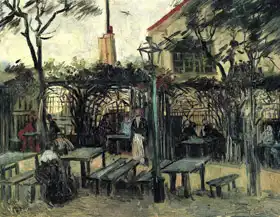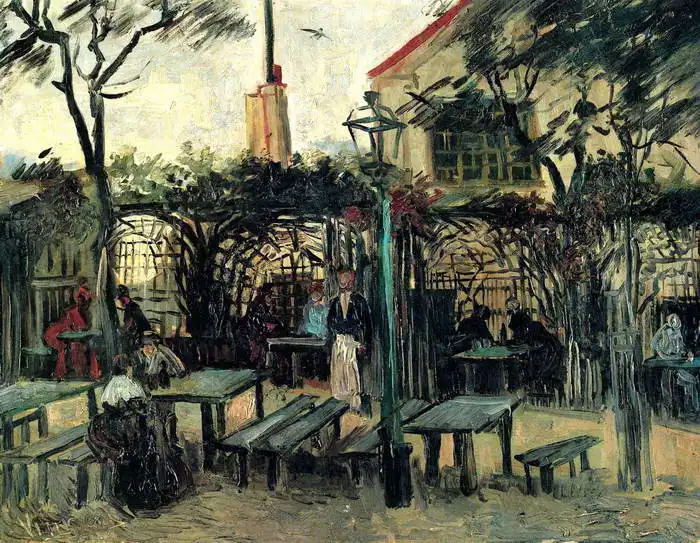About this finishing
Print. The image is printed on the top quality 10-ink HP Z9PS printer on HP matte 270 g / m2 paper. You can choose any size to an accuracy of 1 cm. A margin of 5 cm around the image is added to the size of the motif.


You can find a detailed description about our finishings
here.
Garden cafe on Montmartre La Guinguette
Date:
1886"Garden of a Cafe in Montmartre, La Guinguette" is an oil painting by
Vincent Willem van Gogh that was painted in 1886. This painting depicts a country cafe in the Montmartre district of Paris, which was a popular place for entertainment and relaxation in the late 19th century.
The painting "Garden of a cafe in Montmartre, La Guinguette" shows a cafe garden with
people sitting at tables and enjoying their free time. The atmosphere is cheerful and relaxed, reflecting the social life of the time. The garden is illuminated with lights and evening spotlights, which creates a relaxing atmosphere.
This painting shows van Gogh's
Post-Impressionist style, which is characterized by strong colors, playful use of brushwork, and an emphasis on light effects. Van Gogh focused on capturing emotions and moods in his paintings and often used rich colors to express his feelings.
"Garden of a Cafe in Montmartre, La Guinguette" is one of van Gogh's works that captures the joy of life and social atmosphere, which is different from many of his later melancholy and introspective works. This painting is an important example of his artistic talent and feeling for capturing the life around him.
Gogh painted picture Garden cafe on Montmartre La Guinguette in 1886. Prevailing color of this fine art print is green and its shape is landscape. This image is printed on demand - you can choose material, size and finishing.
Vincent Willem van Gogh (1853-1890). Dutch painter belonging to
Post-Impressionism. His paintings (some 900 paintings and 1,100 drawings and sketches) are among the most famous in the world and are sold for exorbitant sums (except for those in our shop).
Parisian Impressionists He lived in Paris from 1886 and was influenced by the use of bright colours - most of his works were painted during this period. In his paintings, Gogh uses contrasting colours (often blue and orange - he said that I want to use colours other contrasts to each of them shone even more to contrast a man and a woman). He was known for his excesses and amputated an ear after the break-up of his friendship with
Gauguin. There is a lot of speculation about this incident (he possibly suffered from heavy metal poisoning from paint that had caused mental problems). In 1890, unfortunately he committed suicide.


